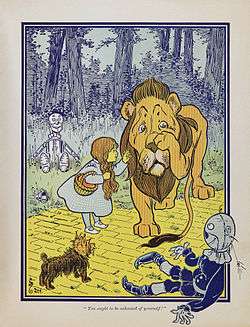Cowardice
Cowardice is a trait wherein excessive fear prevents an individual from taking a risk or facing danger.[1][2] It is the opposite of courage. As a label, "cowardice" indicates a failure of character in the face of a challenge. One who succumbs to cowardice is known as a coward.[3]

Many military codes of justice proscribe cowardice in combat as a crime punishable by death (note the phrase "shot at dawn").
As the opposite of an action or trait that many existing and formerly extant cultures demand, cowardice rates as a character flaw that many societies and their representatives stigmatize and/or punish.
Etymology
According to the Online Etymology Dictionary, the word coward came into English from the Old French word coart (modern French couard), which is a combination of the word for "tail" (Modern French queue, Latin cauda) and an agent noun suffix. It would therefore have meant "one with a tail", which may conjur an image of an animal displaying its tail in flight of fear ("turning tail"), or a dog's habit of putting its tail between its legs when it is afraid. Like many other English words of French origin, this word was introduced in the English language by the French-speaking Normans, after the Norman conquest of England in 1066.[4]
The English surname Coward (as in Noël Coward), however, has the same origin and meaning as the word "cowherd".
Military law
Acts of cowardice have long been punishable by military law, which defines a wide range of cowardly offenses, including desertion in face of the enemy and surrendering to the enemy against orders. The punishment for such acts is typically severe, ranging from corporal punishment to the death sentence. Cowardly conduct is specifically mentioned within the United States Uniform Code of Military Justice, in Article 99.
Generally, cowardice was punishable by execution during World War I, and those who were caught were often court-martialed and, in many cases, executed by firing squad. British men executed for cowardice were often not commemorated on war memorials, and their families often did not receive benefits and had to endure social stigma.[5][6] However, many decades later, those soldiers all received posthumous pardons in the Armed Forces Act 2006 and have been commemorated with the Shot at Dawn Memorial. Unlike British, French, German, and Soviet/Russian forces, the United States forces tried soldiers for cowardice but never followed through with execution while German commanders were less inclined to use execution as a form of punishment.[7]
Considerable controversy was generated by military historian S.L.A. Marshall, who claimed that 75% of U.S. combat troops in World War II never fired at the enemy for the purpose of killing, even while under direct threat. Author Dave Grossman attempted to explain these findings in his book On Killing: The Psychological Cost of Learning to Kill in War and Society . Marshall's findings were later challenged as mistaken or even fabricated,[8][9][10] and were not replicated in a more rigorous study of Canadian troops in World War II.[11]
References
- "Cowardly definition and meaning | Collins English Dictionary". www.collinsdictionary.com. Retrieved 2019-07-05.
- https://www.merriam-webster.com/dictionary/coward
- "cowardice". Dictionary.reference.com. reference.com. Lexico Publishing Group, LLC. Archived from the original on 28 April 2007. Retrieved 24 February 2019.
[the] lack of courage to face danger, difficulty, opposition, pain, etc.
- Garreau, Joseph E. "From French to English:Surprising Etymology". Department of Languages of the UMASS Lowell. Retrieved 16 December 2015.
- Norton-Taylor, Richard (16 August 2006). "Executed WW1 soldiers to be given pardons". The Guardian. Guardian News & Media Limited. Retrieved 24 February 2019.
- "Call to rethink cases of French WWI 'coward' soldiers". BBC News. BBC. 1 October 2013. Retrieved 24 February 2019.
- Woodward, David R. (2009). World War I Almanac. Infobase Publishing. p. 28. ISBN 9781438118963.
- Engen, Robert. "Killing for Their Country: A New Look At "Killology"". Canadian Military Journal. 9 (2). Archived from the original on 21 July 2011. Retrieved 8 May 2011.
As a military historian, I am instinctively skeptical of any work or theory that claims to overturn all existing scholarship – indeed, overturn an entire academic discipline – in one fell swoop...[however] Lieutenant Colonel Grossman’s appeals to biology and psychology are flawed, and that the bulwark of his historical evidence – S.L.A. Marshall’s assertion that soldiers do not fire their weapons – can be verifiably disproven.
- Spiller, Roger J. (Winter 1988). "S.L.A. Marshall and the Ratio of Fire". RUSI Journal. pp. 63–71. Archived from the original on 10 December 2005 – via War Chronicle.
- Smoler, Fredric (March 1989). "The Secret Of The Soldiers Who Didn't Shoot". American Heritage. Vol. 40 no. 2. Retrieved 24 February 2019.
- Engen, Robert Charles (March 2008). Canadians Against Fire: Canada's Soldiers and Marshall's "Ratio of Fire" 1944-1945 (PDF) (Thesis). Kingston, Ontario: Queen's University. p. 142. hdl:1974/1081. Retrieved 24 February 2019.